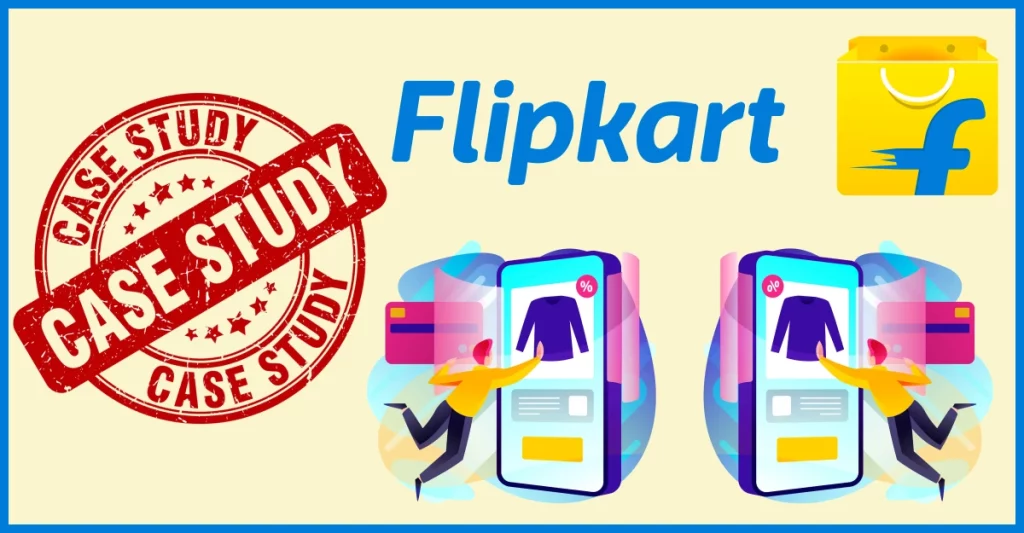When it comes to success stories, the Flipkart Case Study has been the most anticipated one! Reason? A company from its humble beginnings rose to fame so immensely that now it has become synonymous with online shopping. Just like Google is synonymous with search engines and Paytm is synonymous with online payment in India!
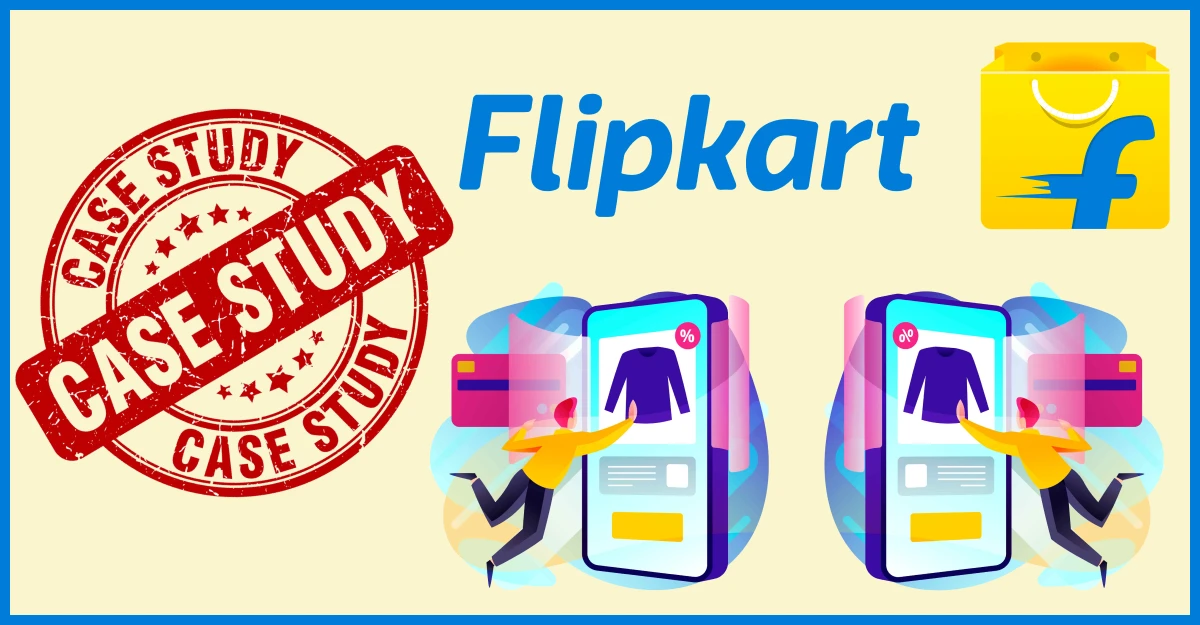
Let me tell you that when a brand becomes synonymous with a process, then that’s solid evidence of success.
Coming back to the point, Flipkart, the Indian e-commerce giant changed how you shop online. From its start, facing challenges, to becoming a big player in online retail, Flipkart’s journey is fascinating.
In this Flipkart Case Study, we will look at its early days, growth strategies, and the impact it had on how Indians shop. Also, its key moments include its joining forces with Walmart and still, it continues to evolve.
So, without any delay, let’s go through the Flipkart Case Study to understand Flipkart’s rise and how it shaped the e-commerce landscape in India.
(A) What is Flipkart? A Brief Overview
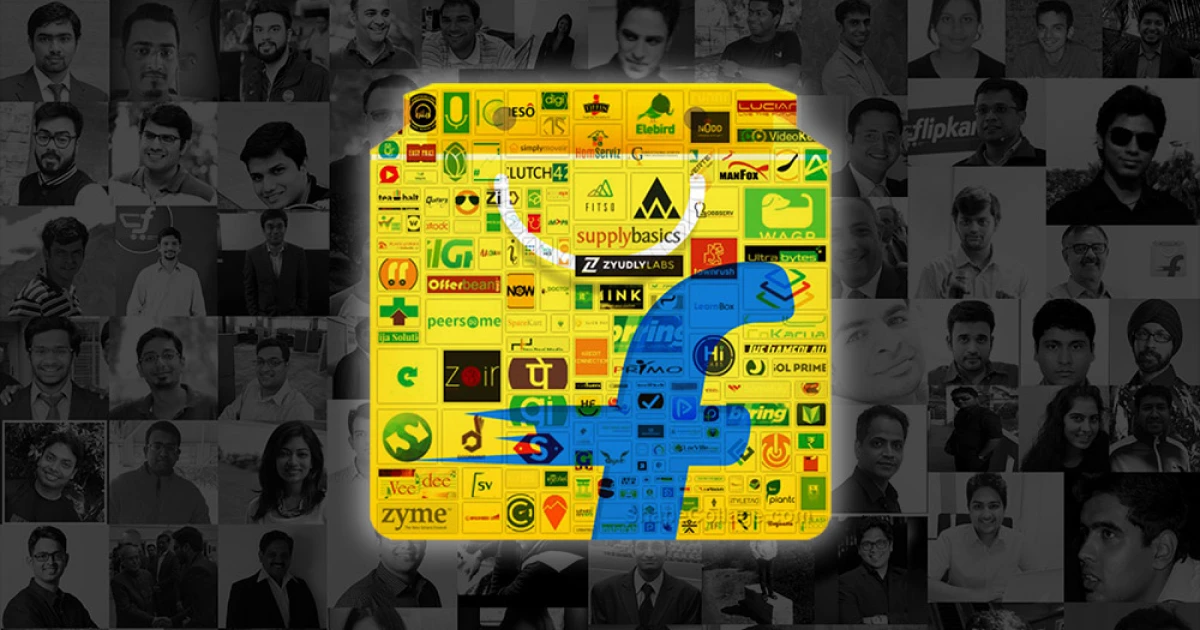
Flipkart Private Limited, an Indian multinational e-commerce giant, has its headquarters in Bangalore and is incorporated as a private limited company in Singapore. The company’s journey began with a primary focus on online book sales. However, as it evolved, Flipkart expanded its product range to include diverse categories such as consumer electronics, fashion, home essentials, groceries, and lifestyle products.
In the competitive landscape of the Indian e-commerce industry, Flipkart is a key player, directly competing with major entities like Amazon India and local rival Snapdeal.
Note: We have already explained “Why did Snapdeal fail? Complete Snapdeal Case Study” in detail. Check out the article for depth information.
As of March 2023, Flipkart held a significant market share, boasting 51% dominance in the country’s e-commerce sector.
One notable aspect contributing to Flipkart’s success is its strategic acquisition of Myntra, which has solidified its position in the apparel segment. This move has been pivotal in establishing Flipkart as a dominant force in the online fashion market.
Moreover, Flipkart has successfully positioned itself as a strong contender against Amazon in the sale of electronics and mobile phones, showcasing its versatility and adaptability in catering to diverse consumer needs.
We will explain it in more detail in the upcoming sections.
For now, let’s have a look at Flipkart’s profile-
| Name of the Company | Flipkart |
| Type of Company | Private & Subsidiary |
| Parent Company | Walmart |
| Operating Industry | E-Commerce |
| Founded in | 2007 |
| Founder | Sachin Bansal,Binny Bansal |
| Headquarters | Bangalore (Karnataka, India- Operational HQ) Singapore(Legal Domicile) |
| Area Served | India |
| Services | Online Shopping |
| Market Valuation | $37.6 billion |
| Revenue Earned (2022) | $7.7 billion |
| Subsidiaries | ANS Commerce, Cleartrip, Ekart, Flipkart Health+, Flipkart Wholesale, Jeeves-F1, Myntra, Shopsy, Yaantra |
| Competitors | Amazon, Ajio, Alibaba, Snapdeal, Shopclues, Myntra, ETSY, etc. |
In essence, Flipkart’s trajectory from an online book retailer to a multifaceted e-commerce giant is marked by strategic expansions, key acquisitions, and robust competition in the dynamic Indian market.
(B) History of Flipkart
Flipkart’s foundation in India was laid in October 2007 by Sachin Bansal and Binny Bansal, both alumni of IIT Delhi and former employees of Amazon. The duo initiated their venture from a modest two-bedroom apartment in Koramangala, Bangalore.
Fueled by their vision to revolutionize online retail, the initial investment of INR 2 lakh from each founder’s family set the stage for what would become a transformative journey.
Starting as an online bookstore with a nationwide shipping approach, Flipkart strategically focused on the sale of books. The company gradually gained prominence, processing 100 orders per day by 2008. This early success laid the groundwork for Flipkart’s expansion beyond books into diverse product categories.
Now, let’s briefly look at the history of Flipkart-
| Year | Key Events & Milestones |
| 2007 | Founded in Bangalore by Sachin and Binny Bansal, focusing on online book sales. |
| 2010 | Acquired We Read and expanded offerings to country-wide book sales. |
| 2012 | Acquired Letsbuy, entering the electronics retail sector. |
| 2014 | Acquired Myntra for US$280 million, reprised Big Billion Days event with significant success. |
| 2015 | Acquired Appiterate, MapmyIndia, and PhonePe. |
| 2016 | Acquired Jabong.com and invested in TinyStep. |
| 2017 | Acquired eBay.in and made an unsuccessful offer to acquire Snapdeal. |
| 2018 | Walmart acquired a 77% controlling stake in Flipkart for US$16 billion. |
| 2019 | Invested US$4 million in EasyRewardz. |
| 2020 | Launched Flipkart Wholesale, acquired a stake in Arvind Youth Brands, and introduced Flipkart Quick. |
| 2021 | Acquired Cleartrip and ventured into the hotel industry. |
| 2022 | Launched the Flipkart Foundation, entered NFT and Web3 segment, and created Flipverse. |
| 2023 | Introduced ‘Flipkart Student’s Club’ and ‘Flipkart Green’. |
| 2024 | Binny Bansal resigned, selling his stake to Walmart. |
The journey from a small startup to an e-commerce giant included significant milestones such as the acquisition of We Read in 2010, further diversifying Flipkart’s offerings. This period marked the foundation of Flipkart’s presence in the Indian market, and its commitment to customer satisfaction and innovation paved the way for its subsequent growth, mergers, and acquisitions in the years to come.
(C) Growth Strategies: How did Flipkart rise in the Indian e-commerce market?
Flipkart rose in the Indian market by opting for numerous effective strategies. Go through the following table and you will get to know it-
| Key Growth Strategies | Particulars | Details |
| Customer-Centric Approach | Customer Satisfaction | Flipkart prioritized customer satisfaction by offering competitive prices, a user-friendly interface, and reliable delivery. |
| Cash on Delivery | Their “Cash on Delivery” option addressed trust issues in the Indian market. | |
| Innovative Strategies | Big Billion Days | Flipkart pioneered the concept of annual sales events like “Big Billion Days,” offering massive discounts and attracting millions of shoppers. |
| Mobile-First Approach | Recognizing the surge in mobile internet usage, Flipkart optimized its platform for mobile devices. | |
| Logistics and Supply Chain | Timely Delivery | Flipkart invested heavily in building a robust logistics network, ensuring timely deliveries across India. |
| New Programmes | Their “Flipkart Assured” program guarantees quality products and faster shipping. | |
| Marketplace Model | Pivot | Flipkart transitioned from an inventory-based model to a marketplace, allowing third-party sellers to list their products. |
| Versatile Products | This expanded their product catalog without the need for massive inventory investments. | |
| Acquisitions and Strategic Alliances | Acquisitions | Flipkart acquired companies like Myntra, Jabong, and PhonePe, strengthening its position in fashion and digital payments. |
| Smartphone Launching Events | Partnerships with smartphone brands for exclusive launches boosted their visibility. | |
| Funding & Investments | Secured Funding | Flipkart secured significant funding from investors like Tiger Global, SoftBank, and Microsoft. These investments fueled growth and allowed them to compete with global players like Amazon. |
| Adaptation to Changing Trends | Opting new technologies | Flipkart embraced new technologies, including AI-driven recommendations and personalized experiences. They expanded into grocery delivery, recognizing the potential in this segment. |
| Challenges and Regulatory Scrutiny | Setbacks | Flipkart faced challenges related to competition from Amazon, changing regulations, and allegations of unfair practices. |
| Regulations | The government scrutinized their business model and marketplace policies. | |
| Walmart Acquisition | Majority stake in Flipkart | In 2018, Walmart acquired a majority stake in Flipkart for $16 billion. This deal provided Flipkart with additional resources and global expertise. |
Imagine a journey that begins with a small team, determined to redefine how people shop online. That’s the story of Flipkart, and it’s a tale filled with strategic moves and innovative thinking.
From the outset, customer satisfaction was at the forefront of Flipkart’s strategy. They understood the importance of competitive pricing, a user-friendly interface, and reliable delivery to win over the hearts of Indian shoppers. Introducing the “Cash on Delivery” option addressed trust concerns in a market where online payments were met with skepticism.
But Flipkart didn’t stop there.
They introduced groundbreaking events like “Big Billion Days,” turning ordinary shopping into a festival of massive discounts. Recognizing the shift towards mobile internet usage, they optimized their platform for mobile devices, making shopping accessible to millions on the go.
Building a robust logistics network became a cornerstone for Flipkart. Timely delivery, coupled with innovative programs like “Flipkart Assured,” ensured quality products reached customers swiftly. The transition from an inventory-based model to a marketplace allowed third-party sellers to join in, expanding Flipkart’s product catalog without huge inventory investments.
Strategic acquisitions, including Myntra, Jabong, and PhonePe, strengthened their position in fashion and digital payments. Partnerships for exclusive smartphone launches boosted their visibility while securing funding from investors like Tiger Global and SoftBank fueled their growth, enabling them to compete globally.
However, every story has its challenges. Flipkart faced setbacks from competition, changing regulations, and allegations of unfair practices. Regulatory scrutiny became a part of their narrative as the government examined their business model.
In a pivotal moment, Walmart stepped into the story, acquiring a majority stake in Flipkart for $16 billion in 2018. This move not only injected additional resources but also brought global expertise to Flipkart’s journey.
From adapting to changing trends, embracing new technologies, and facing challenges head-on, to the transformative Walmart acquisition – Flipkart’s story is a testament to resilience, innovation, and the pursuit of customer satisfaction in the ever-evolving landscape of e-commerce.
(D) Impact of Flipkart on Indian Retail: How has it disrupted the traditional retail models?
Flipkart has significantly disrupted traditional retail models in India, reshaping the landscape and transforming how consumers shop. You have witnessed it too! Let’s look at the impact of Flipkart on the retail landscape of India-
| Areas of the Impact | Particulars | Details |
| Convenience and Accessibility | Anytime, Anywhere Shopping | Flipkart’s online platform provides consumers with the convenience of shopping at any time from the comfort of their homes, breaking away from the constraints of traditional store hours. |
| Nationwide Reach | It has expanded access to products for consumers in remote areas, overcoming geographical limitations associated with brick-and-mortar stores. | |
| Diverse Product Range | Extensive Catalog | Flipkart’s vast product catalog spans various categories, offering consumers a diverse range of choices beyond what traditional stores might carry. |
| Specialized Offerings | The transition from Inventory-Based to Marketplace | |
| Competitive Pricing and Discounts | Promotional Events | Flipkart’s pioneering concept of events like “Big Billion Days” disrupted the traditional sales model, attracting millions with massive discounts and exclusive deals. |
| Price Transparency | Online platforms like Flipkart promote price transparency, allowing consumers to easily compare prices and make informed purchasing decisions. | |
| Innovative Shopping Experience | User-Friendly Interface | Flipkart’s user-friendly interface and innovative features enhance the overall shopping experience, introducing elements like personalized recommendations and reviews. |
| Mobile-First Approach | Recognizing the surge in mobile internet usage, Flipkart optimized its platform for mobile devices, making shopping accessible to a broader audience. | |
| Logistics and Timely Delivery | Efficient Supply Chain | Heavy investment in logistics ensures timely deliveries across India, addressing one of the common challenges faced by traditional retailers. |
| Quality Assurance Programs | Initiatives like “Flipkart Assured” guarantee quality products and faster shipping, enhancing customer trust. | |
| Marketplace Model | Transition from Inventory-Based to Marketplace | Flipkart’s shift from an inventory-based model to a marketplace allows third-party sellers to list their products. This increases the product range without the need for massive inventory investments. |
| Digital Payments and Technology Integration | Acquisition of PhonePe | The acquisition of PhonePe enhanced Flipkart’s presence in digital payments, promoting a seamless and cashless transaction experience for customers. |
| Challenges and Evolution | Adaptation to Changing Trends | Flipkart has adapted to emerging trends, exploring new technologies, expanding into grocery delivery, and entering the NFT and metaverse space in response to evolving consumer preferences. |
The Confederation of All India Traders (CAIT) contends that Flipkart’s practices have adversely affected small retailers. Many traditional retail businesses have struggled to compete, resulting in job losses and a decline in the sector.
The Competition Commission of India (CCI) is currently investigating the allegations against Flipkart. If found guilty, fines or changes in business practices may be imposed. The government is also considering new regulations to promote fair competition in the e-commerce sector.
(E) Business Review: How Flipkart is Performing Businesswise?
Why do we always analyze the companies from a business perspective? You may wonder! Well, this is a crucial aspect of the case studies. It immensely helps investors, stakeholders, and decision-makers.
Looking at Flipkart’s conditions from a business perspective offers insights into its strategies, financial stability, market presence, and customer service approaches.
So, let’s look at the business aspects of Flipkart-
| Business Aspects | Flipkart |
| Company’s Worth | $37.6 billion (market Valuation) |
| Market Share in India | 51% |
| Shareholders | Walmart (80.5%) Tencent (5.3%) Tiger Global (4.1%) Binny Bansal (2.4%) CPPIB (2.2%) SoftBank Group (1.4%) QIA (1.3%) Microsoft (1.2%) Accel (1.1%) Others (0.5%) |
| Revenue Earned | Rs.51,176 crore (FY22) Rs.56,013 crore (FY23) |
| Expenses | Rs.54,580 crore (FY22) Rs.60,858.5 crore (FY23) |
| Loss | Rs.3,371.2 crore (FY22) Rs.4,890.6 crore (FY23) |
From the table, it’s evident that Flipkart holds a substantial market valuation of $37.6 billion, boasting a dominant 51% market share in India. The major shareholder is Walmart, holding an 80.5% stake.
Despite a significant revenue increase from Rs.51,176 crore (FY22) to Rs.56,013 crore (FY23), expenses also escalated from Rs.54,580 crore to Rs.60,858.5 crore.
The company reported losses of Rs.3,371.2 crore (FY22) and Rs.4,890.6 crore (FY23). This data provides a snapshot of Flipkart’s financial landscape, showcasing its valuation, market share, shareholder structure, revenue, expenses, and losses in the specified fiscal years.
(F) Competitive Landscape of Flipkart
Flipkart operates in a highly competitive e-commerce landscape in India facing fierce competition from various players. The key rivals include-
- Amazon India: One of the major competitors, Amazon has a substantial presence in India, offering a diverse range of products and services. The battle for market share between Flipkart and Amazon is a defining aspect of the e-commerce landscape. We have thoroughly explained Amazon vs Flipkart. You can check that article for detailed information.
- Snapdeal: Though not as dominant as Flipkart and Amazon, Snapdeal remains a significant player, especially in certain product categories. The competition with Snapdeal adds to the dynamic nature of the market.
- New Entrants: The e-commerce sector in India has witnessed the entry of new players, both domestic and international, intensifying the rivalry and driving innovation in the industry.
Every year, Flipkart hosts a huge event called the “Big Billion Days” where they offer big discounts and special deals to attract lots of shoppers.
Flipkart’s focus is on making customers happy. They keep prices low, make the website easy to use, and deliver orders reliably.
One smart move they made was changing how they sell things – instead of owning all the products, they let other sellers join their platform, giving customers more choices without needing a huge warehouse.
Along the way, Flipkart made important friends by acquiring companies like Myntra, Jabong, and PhonePe. These additions helped Flipkart become better in fashion and digital payments.
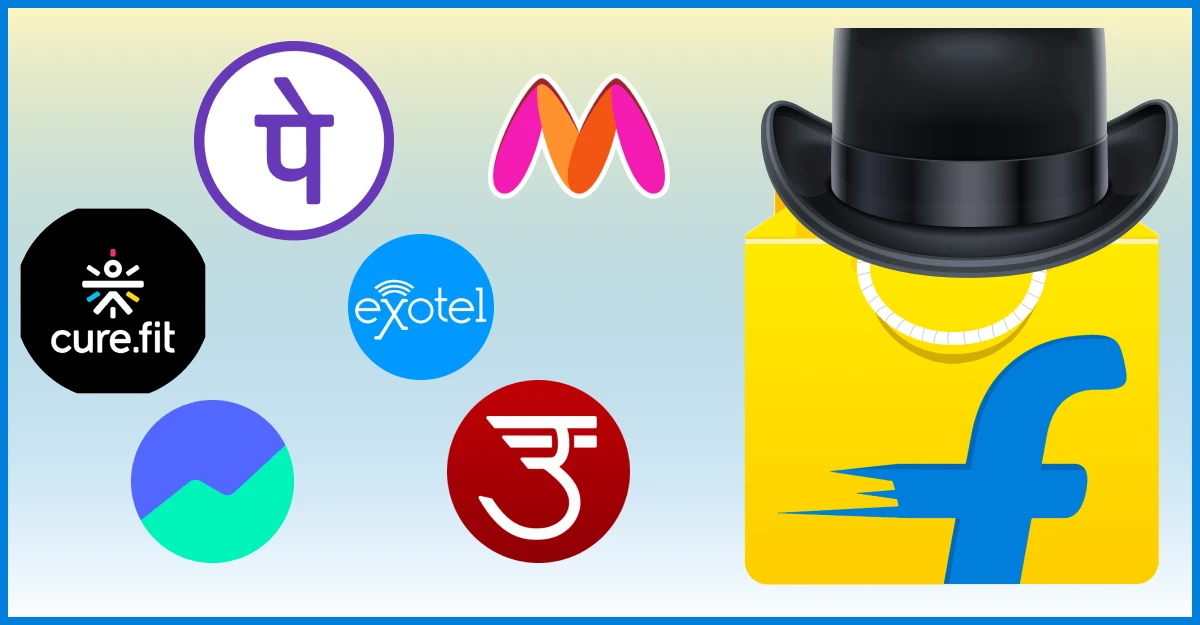
To keep up in this fast-changing world, Flipkart also uses technology well, especially on mobile phones. They invest a lot in making sure orders reach customers on time. Despite facing challenges,
Flipkart’s story shows how they adapt and compete, making them a big player in India’s online shopping tale!
(G) Challenges Faced by Flipkart
Here are some of the tough challenges that Flipkart faced while commencing its operations in India-
| Challenges | Impact & Context |
| Cost Structure of Logistics | E-commerce in India operates in a low ticket price market. Logistics costs pose a significant challenge for Flipkart. Lowering logistics costs is crucial for further increasing e-commerce penetration. |
| Competition from Amazon | Amazon, another major player in Indian e-commerce, competes fiercely with Flipkart. Both companies vie for market share and customer loyalty. |
| Regulatory Scrutiny and Allegations | Flipkart has faced allegations related to exclusive launch agreements, fake sellers, and market dominance. The Competition Commission of India (CCI) is investigating these practices. |
| Adapting to Changing Trends and Technology | Keeping up with technological advancements and consumer preferences is essential. Flipkart must innovate to stay relevant. |
| Balancing Growth and Profitability | While growth is crucial, achieving profitability remains a challenge. Balancing investments, discounts, and operational costs is a delicate task. |
These challenges reflect the dynamic nature of the e-commerce industry and the need for strategic agility by Flipkart.
(H) Post-Acquisition Developments of Flipkart
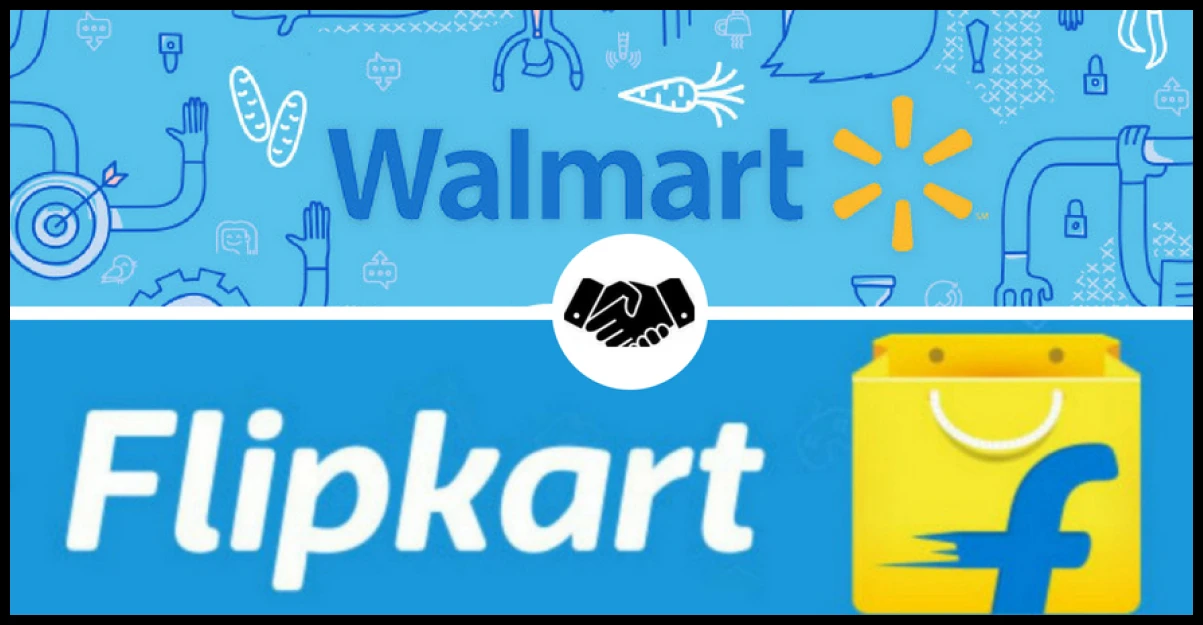
Let’s go through the post-acquisition developments of Flipkart following Walmart’s acquisition-
| Post-Acquisition Development | Details |
| Acquisition Details | In 2018, Walmart acquired a 77% stake in Flipkart for approximately $16 billion. This deal valued the 11-year-old Indian e-commerce firm at $20.8 billion. |
| Immediate Impact | The acquisition provided SoftBank Vision Fund with a profitable exit, as they had previously invested heavily in Flipkart. Tiger Global, another major investor, also benefited significantly from the deal. Flipkart’s Indian founders and employees secured a smaller share of the valuation around 10%. |
| Transition to Electric Vehicles | Flipkart announced plans to transition its delivery fleet to electric vehicles by 2030. This move aligns with sustainability goals and contributes to reducing the company’s environmental impact. |
| Continued Growth and Challenges | Despite challenges, including the cost structure of logistics, Flipkart remains a dominant player in the Indian e-commerce market. The company posted a 9.4% increase in consolidated net total income for FY23. However, its losses widened due to investments and operational costs. |
| Innovation and Sustainability | In July 2021, Flipkart achieved the milestone of 100% elimination of single-use plastic packaging throughout its supply chain ecosystem. The company continues to focus on innovation and sustainable practices. |
Thus, Walmart’s acquisition of Flipkart brought both opportunities and challenges. Simultaneously, it immensely helped in shaping the e-commerce ecosystem in India and impacted millions of consumers.
(I) Wrapping Up the Flipkart Case Study
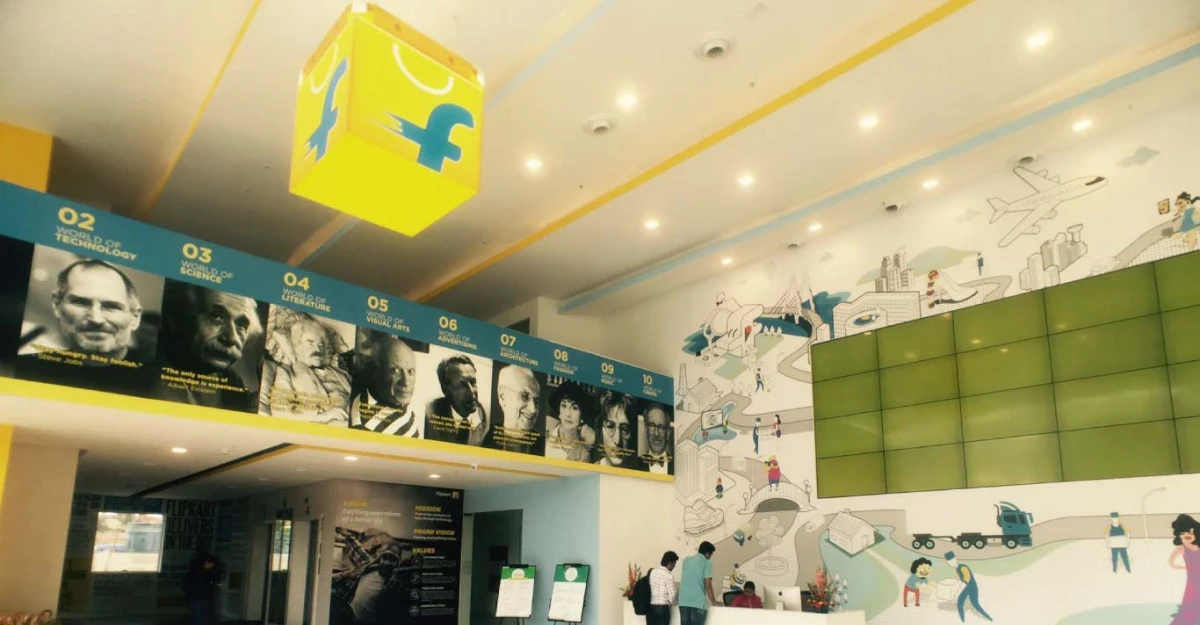
In a nutshell, Flipkart’s journey from a small startup in 2007 to an Indian e-commerce giant is marked by strategic innovation, customer-centricity, and adaptability. Pioneering events like “Big Billion Days,” embracing a marketplace model, and strategic acquisitions have been pivotal.
The company’s commitment to customer satisfaction, technological integration, and expansion into diverse segments showcase its resilience. The acquisition by Walmart in 2018 added global expertise, propelling Flipkart to a $37.6 billion valuation.
As it ventures into new territories, Flipkart’s story remains a testament to its impact on India’s retail landscape and its ability to evolve with changing times!

